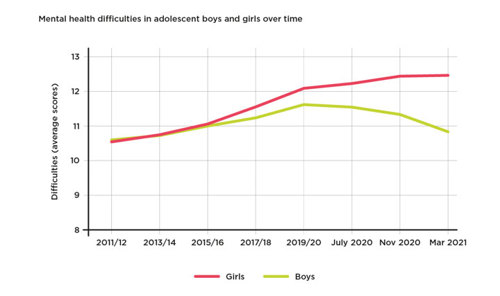Young people’s mental health and wellbeing during Covid-19
Thursday 1 December 2022
 It has been almost three years since we first heard about Covid-19 and as we now come out on the other side, it seems a good time to reflect on how the pandemic may have impacted us.
It has been almost three years since we first heard about Covid-19 and as we now come out on the other side, it seems a good time to reflect on how the pandemic may have impacted us.
Unsurprisingly, it appears that children’s and young people's academic performance has suffered as a result of the lockdown and school closures. But in reality, life is not just about being able to read and write. Critical events, such as a pandemic, can affect us in many other ways. It may, for example, affect our financial situation, or how happy we are with our lives. The diagram below shows the impact of the pandemic on aspects of family life from The Children’s Society survey of adolescents aged 10 to 17 in June 2022.

Although they are related concepts, wellbeing and mental health are not the same thing and can be measured in many different ways. For example, 2018’s Programme for International Student Assessment looked at the wellbeing of adolescents and found that only 53 per cent being satisfied with life, even lower than in 2015 (58%). Recent reports from around the world suggest the wellbeing and mental health of children and young people has been on a downward trend for some time now and continues to decline today.
However, everyone has experienced the pandemic differently. So do those findings speak for all? You won't be surprised to hear that the picture of how our mental health has changed during the pandemic is much more complex. It may be that there were moments where even the smallest thing made you very upset, or perhaps at times the different pace of life felt acceptable or even more enjoyable.
You may find it interesting that in a survey¹ of almost 17,000 eight- to 18-year-olds conducted during the pandemic, a third experienced worse mental health, a third experienced no change and a third experienced improved mental health during the pandemic. So whichever way you may have been feeling is perfectly normal and you are not alone with your views.
NFER’s recently published study reviewed a cross-section of research exploring children and young people’s wellbeing and mental health during Covid-19, and how certain groups of people may have been affected differently. Essentially, the report shows that for some, the periods of partial school closure, and in particular the first lockdown², led to some improvements in their wellbeing or mental health – and this was particularly true for some who experienced anxiety and depressive symptoms before the pandemic.
For others, the pandemic was linked to poorer mental health. NFER analysed data from the Understanding Society Main survey as well as the Covid-19 survey in which adolescents described their experiences and found that their mental health had got worse since 2011. The diagram below shows how adolescents’ mental health difficulties changed between 2011 and 2021; the higher the score the poorer the mental health. Adolescent girls were particularly vulnerable to the lockdowns as their mental health continued to decline into, and throughout, the pandemic. There was a different pattern for adolescent boys who reported slightly better mental health in July 2020, just after the first lockdown period, and continued to improve. However, the opposite seems to be true for younger children. Primary-aged boys seemed more vulnerable to declines in mental health during the pandemic than girls.

[1] Soneson, E. Puntis, S., Chapman, N., Mansfield, K.L., Jones, P.B. and Fazel, M. (2022). 'Happier during lockdown: a descriptive analysis of self‑reported wellbeing in 17,000 UK school students during Covid‑19 lockdown', European Child and Adolescent Psychiatry, 1–16 [online]. DOI 10.1007/s00787-021-01934-z.
[2] There is fluctuation in the levels of mental health throughout the pandemic and there is evidence that the second lockdown in early 2021 may have had a more negative impact than the first lockdown.
When looking at how the pandemic has affected children and young people who come from deprived households, or those with special educational needs and disabilities (SEND), the story gets even more complicated. Surveys before the start of the pandemic showed that disadvantaged children and young people had, on average, poorer wellbeing and worse mental health than their non-disadvantaged friends. Some of the more recent surveys have reported that the pandemic had a particularly negative impact on the mental health of adolescents from deprived households. Others found no evidence for this link and suggested there was not much change to the challenges already experienced. Similarly, we can’t say for sure whether children and young people with SEND had worse mental health during the pandemic than that of those without SEND. It is possible that this gap has also narrowed.
Often, it seems we are dealing with a continuation of pre-pandemic patterns and not actual effects of the pandemic. It is very difficult to estimate the actual impact of the pandemic on wellbeing and mental health for a number of reasons. For example, different studies use different measures to assess either wellbeing or mental health and focus on different age-groups. Some surveys may actually have been completed by parents or carers and might not accurately reflect how the young person was feeling. Additionally, studies have been carried out at different time-points in the pandemic, during which restrictions changed, and do not have baseline data, meaning they cannot compare it to people’s wellbeing or mental health before or without the pandemic. And so, without having this comparison, we cannot say how wellbeing and mental health would have changed if the pandemic had not happened.
As we come out of the global pandemic, it is important to reflect on how each of us is feeling and to take time to look after our mental health. Whilst we have all been in the same storm, we have not been in the same boat, and the consequences are different for different people. It can help to listen to what others have to say and to share our own thoughts and experiences. For some ideas on how to start a conversation about mental health you can go to the following websites:
Summary
- It is difficult to reliably establish long-term impacts of the pandemic on young people’s wellbeing and mental health.
- The story is very complex: Some young people have flourished as a result of a change in habits while others have found it more difficult.
- Every individual has their own story to tell: what helps to improve one person’s wellbeing and mental health might not work for others.
If you want to know more about the research referred to in this blog, you can find the full studies here: Children and young people’s wellbeing and mental health during the Covid-19 pandemic.
References
Kuhn, L., Bradshaw, S., Donkin, A., Fletcher, L., Liht, J. and Wheater, R. (2021). PISA 2018 additional analyses: What does PISA tell us about the wellbeing of 15-year-olds? [online]. Available: www.nfer.ac.uk/pisa-2018-additional-analyses-what-does-pisa-tell-us-about-the-wellbeing-of-15-year-olds/ [29 November, 2022].
NHS Digital (2020). Mental Health of Children and Young People in England, 2020: Wave 1 Follow up to the 2017 Survey [online]. Available:www.digital.nhs.uk/data-and-information/publications/statistical/mental-health-of-children-and-young-people-in-england/2020-wave-1-follow-up [29 November, 2022].
The Children’s Society (2022). The Good Childhood Report 2022 [online]. Available: www.childrenssociety.org.uk/information/professionals/resources/good-childhood-report-2022 [29 November, 2022].
Twist, L., Jones, E. and Treleaven, O. (2022). The Impact of Covid-19 on Pupil Attainment [online]. Available: www.nfer.ac.uk/the-impact-of-covid-19-on-pupil-attainment-a-summary-of-research-evidence/ [29 November, 2022].
University of Essex and Institute for Social and Economic Research (2022) ‘Understanding Society: Waves 1-12, 2009-2021 and Harmonised BHPS: Waves 1-18, 1991-2009. 17th Edition’. UK Data Service. Available at: www.doi.org/10.5255/UKDA-SN-6614-18.
University of Essex and Institute for Social and Economic Research (2021) ‘Understanding Society: COVID-19 Study, 2020-2021. 11th Edition’. UK Data Service. Available at: www.doi.org/10.5255/UKDA-SN-8644-11.
